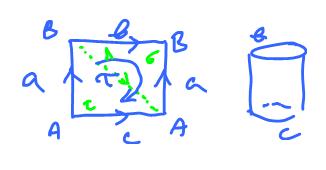This site is being phased out.
Boundary group
Definition. The $k$-boundary group of cell complex $K$ is the set of all boundaries of the $(k+1)$-chains in $K$, i.e., it's the image of the $(k+1)$-chain group: $$B_k(K) = \partial (C_{k+1}(K)),$$
where $\partial$ is the boundary operator.
Let's find the boundary group of the cylinder, by examination. First, list the chain groups generated by the cells: $$\begin{array}{l} C_2(K) = < \tau >, \\ C_1(K) = <a, b, c>, \\ C_0(K) = <A, B>. \end{array}$$
Next, $$\begin{array}{l} B_1(K) = < \partial \tau > = <a + b - a - c> = < b - c >, \\ B_0(K) = < \partial a, \partial b, \partial c> = < B - A, B - B, A - A > = < B - A, 0, 0 > = < B - A >. \end{array}$$
This data is understood as $$b - c \sim 0,$$ $$B - A \sim 0.$$
Or: $b$ is homologous to $c, B$ is homologous to $A$ (see Homology as an equivalence relation).
Exercise. How does the above computation change if we cut the $2$-cell into two, as shown?
